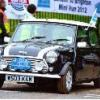Whats Nuts And Bolts ?
#16

Posted 01 February 2013 - 05:08 PM
#17

Posted 01 February 2013 - 05:40 PM
What thinkest thou, Tiger?
#18

Posted 01 February 2013 - 05:43 PM
I tend to buy the proper ones as I need them and keep a few generic sizes & nuts.
Rally515,
You're usually better off buying sets than loose taps & dies, but it's always worth keeping an eye on ebay
http://www.tracytools.com/
http://www.rdgtools.co.uk/
#19

Posted 01 February 2013 - 05:55 PM
I always wonder is the tie-bar bolt clamping the tie-rod fork and thus putting a bending load into the fork end is ideal. If it was an aircraft the fork end would be a 'floating' fit over the lower arm with a 'stepped' bolt and thrust washers each side or a bush through both parts and a smaller bolt carrying no dynamic loading to retain it. That would ensure that only true end-loads were applied into the rod.
What thinkest thou, Tiger?
The chunky, heavy duty adjustable bars we all buy probably achieve that don't they? By rights the hole is probably in the wrong place though, horizontal would be better.
#20

Posted 01 February 2013 - 05:58 PM
I always wonder is the tie-bar bolt clamping the tie-rod fork and thus putting a bending load into the fork end is ideal. If it was an aircraft the fork end would be a 'floating' fit over the lower arm with a 'stepped' bolt and thrust washers each side or a bush through both parts and a smaller bolt carrying no dynamic loading to retain it. That would ensure that only true end-loads were applied into the rod.
What thinkest thou, Tiger?
The chunky, heavy duty adjustable bars we all buy probably achieve that don't they? By rights the hole is probably in the wrong place though, horizontal would be better.
That's absolutely right. Still, a rose-joint at that point would be better still.
#21

Posted 02 February 2013 - 03:14 AM
If you want to see something much worse, have a look at a Hillman Hunter. The lower arm is a pressing, and the tie rod, which uses something resembling Mini bushes at the front, but thicker, with more compliance, is bolted to the top side of the arm, with something like a banjo fitting, not even a fork end, so it induces bending loads in the tie rod and torsion in the arm.
If I remember correctly, the Avenger corrected that error by having a thin metalastik bush at the connection between tie rod and arm to allow some deflection to relieve bending loads. However, my memory is a bit rusty, and it may not have been the Avenger but some other car altogether. I can remember changing these bushes, but am not positive about which car it was.
The Hunter, by the way, seemed to be a product of industrial espionage as it very strongly resembled the MK 2 Cortina, but was an inferior copy. Ford had, in their usual way, obtained fore and aft location by using the anti-roll bar, rubber bushed to the lower arm, but Hillman had to use tie rods, and connect the anti-roll bar with drop links. The Ford handled much better, despite its simplicity, or perhaps because the shell was stiffer and lighter. In a Hunter, the front passenger could feel slight flexing in the floor/bulkhead area where the front chassis rail attached. As for the Avenger, it was a very nice car in many ways, but the monocoque was optimised so well that the roof could not safely be cut to fit a sunroof, one of very few cars with that limitation.
#22

Posted 10 February 2013 - 01:58 PM
The nuts and bolts on a Mini are virtually all either UNF (Unified Fine) or UNC (Unified Coarse). They are not metric.
Most popular sizes are 1/4", 5/16" and 3/8" UNF throughout the engine and the rest of the car, whilst most threaded holes in the aluminium gearbox casing are UNC.
An on-line company, Namrick Limited, are an excellent supplier of nuts, bolt & washers. They do a 450 piece pack of UNF nuts, bolts & washers for a rasonable price.
Make sure you always use Imperial size spanners, 7/16" AF, 1/2" AF and 9/16" AF, and are not tempted to try to use metric sizes.
Amount of people that drive 8mm (m8) bolts down into 5/16 UNF threads is silly, as they have the same thread angle 60* and a similar pitch, they go in a couple of times and then the thread is ruined, I agree, always use imperial stuff, the right stuff!
1 user(s) are reading this topic
0 members, 1 guests, 0 anonymous users















